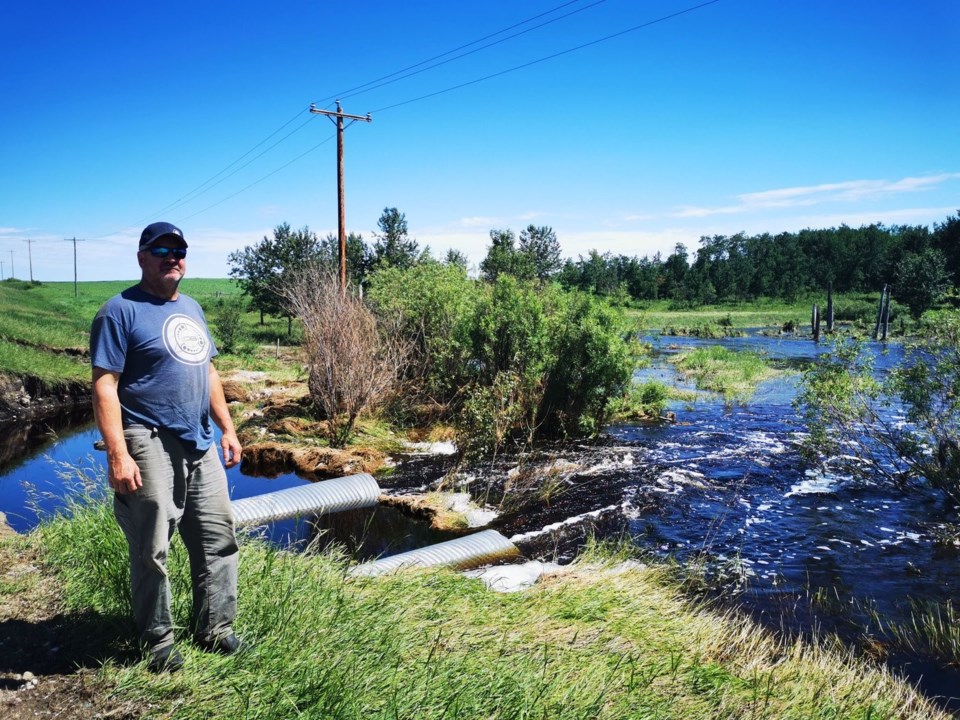To city eyes, the fields to the north of Minnedosa appear magnificently green, with patches of yellow growth and pools of scintillating water adding pleasing elements of nature.
For the hundreds of farmers in the Rural Municipality of Minto-Odanah, that same view only means destruction. This follows a terrible fall with early snow, which meant many crops were not fully taken out.
Thousands of acres of this season’s crops will die because of the unrelenting rainfall this past week. First Sunday night – 10 inches – then again Tuesday – three more inches. By the time Thursday brought two-tenths of an inch, the saturated ground, despite water receding, spelled more disaster.
“We were dry. We needed rain, but not that much,” said Barry Cook, a cattle and grain farmer and councillor for the municipality.
Cook pointed to various fields and said, “It’s not going to come back. It’s gone.”
Fields are also eroded by fast-flowing, bloated streams.
Cook toured The Brandon Sun where he could on Friday, up and down highways and grid roads. He said other areas in the municipality were worse, but roads were impassable.
The area barely gets 10 inches of rain throughout a typical growing season. Fields were sown approximately five to six weeks prior to Sunday’s thunderstorm.
“I can remember four or five inches of rain at a time, a couple of times, but never ten,” Cook said.
Also on Thursday, the powerful wind blew trees down onto power lines, and some were left without power. That meant sump pumps stopped working and basements kept flooding.
“A lot of the water has receded, but it’s done the damage,” Cook said.
Cook owns a newer home on the farm his family has maintained since 1879, which is built on a hill. Yet, water flowed into the basement. He described rain falling in sheets. He and his wife Colleen had to burn what couldn’t be salvaged. Colleen’s garden — a source of food and fun for his three grown daughters and their children — was also inundated.
And as Cook explains, fields, basements and gardens are only one aspect of the troubles facing farmers in the area. Washed or blown-out grid roads — which means double or triple travel time, is one grave challenge for the 744-square-kilometre municipality. There are hundreds of places with washed-out roads, some of which will take a full day or more to repair. Cook said there are 27 miles of closed roads, at the very least. Then there are the roads that are still passable, but with lots of damage.
On one section of highway that goes over a ravine, which from the road is an approximate 70-foot drop, the water was six feet short from going over the highway. Water has accumulated on one side, but not on the other. There is so much debris blocking up culverts, further undermining the structural integrity. Water will find a way through, even if it’s on the outside of the culvert.
On one grid road, the water was so turbulent and the current so strong it blew out the massive culverts like torpedoes. They rest, crushed and bent, approximately 100 feet from the road, which sports a four-foot crevasse.
Accesses to homes were also blown out, meaning the people in a dozen or more farmhouses were stranded. By Friday, only a couple were still stuck.
Pointing to one property, Cook said, “These people can’t get out of their front yard because their bridge is washed out.”
The municipality is taxed trying to get repairs done. It doesn’t help that some people don’t respect the closed-road signs. On Monday, for example, someone drove down a closed, washed-out road near Bethany. Their vehicle was submerged, but the ambulance had a hard time getting to it due to other closed roads. In the end, the vehicle was empty and the owner long gone. The municipality’s foreman then had to plot a map of closed roads for Prairie Mountain Health.
Downed fences meant keeping cattle contained has also been an issue. Cook spent more than two hours on Friday morning fixing a bit of fence that allowed his animals to escape.
The fence had washed away underneath mud, trees and sod. And that’s a defining feature of the low-lying and small ravines now – dead trees piled up in a mess, gravel washed off from the roads and churned-up earth.
While some farmers have had to move their cattle, Cook and his brother spent a couple of hours Monday chasing his 27 cow-calf pairs and one bull around fields, trying to get them back to pasture. On foot and in the mud, he said.
“It wasn’t much fun,” Cook said.
The municipality, which surrounds the Town of Minnedosa, declared a state of local emergency early in the week. The hope is that the provincial and federal governments will help fund clean-up and repairs.
“And it means we can do certain things, too,” said Cook.
“I think if, say, we had to fix something adjacent to someone’s property and we needed clay and they said, ‘No, you can’t come on our property and take that clay.’ In a state of emergency I think we can say, ‘Yeah, we can do that.’ Then we’ll figure it out after that.”
Cook said it’s hard to quantify the effect of the week’s weather event on farmers.
“It affects the bottom line. I don’t know if you can actually put a number on it. I think, more than anything it’s probably hard on your mental state more than anything.”
“It’s something that you worry about all the time.”
How are people coping?
“Most people are pretty good,” Cook said.
“You put your head down, you get rid of your stuff, you pump out, and you start over again.”
He added if the rain stops for a week the area would get back to normal, eventually.
“The ground cannot take any more moisture.”



